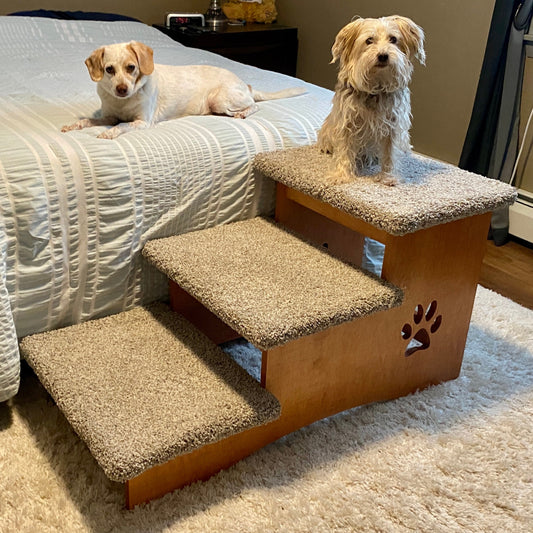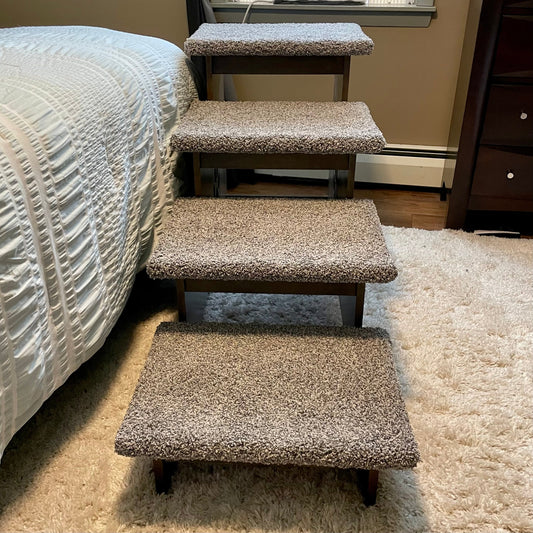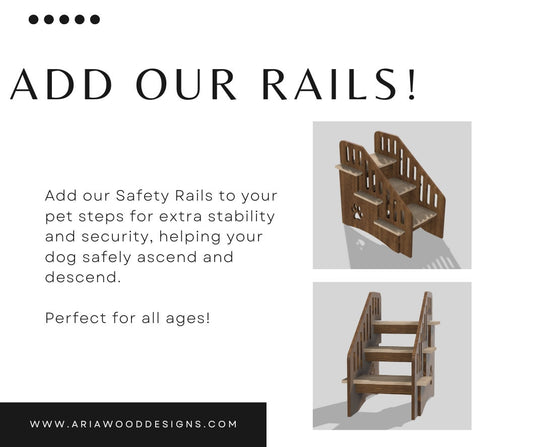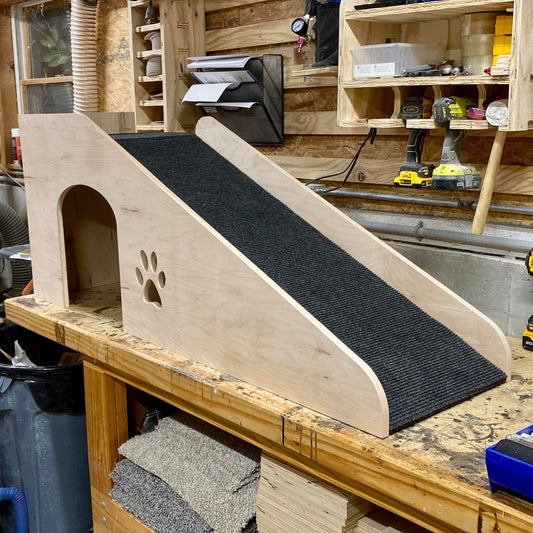Every pet parent knows the heartbreak of watching their beloved companion struggle to reach their favorite sleeping spot. Maybe it's your senior Golden Retriever hesitating at the foot of the bed, or your Dachshund's frustrated whimpers as they try to make that impossible leap onto the couch. When jumping becomes painful or impossible, dog steps and ramps transform from luxury items into essential tools for maintaining your pet's independence and comfort.
Whether you're dealing with a tiny Chihuahua who needs help reaching tall beds, a senior dog managing arthritis, or breeds like Basset Hounds with unique body structures that make jumping challenging, the right mobility solution can dramatically improve your pet's quality of life. The key lies in understanding when your dog needs assistance and choosing between dog stairs and ramps based on their specific needs.
For pet parents seeking handcrafted quality and breed-specific solutions, companies like Aria Wood Designs are revolutionizing the approach to canine mobility. Their expertly crafted steps don't just solve mobility issues—they enhance your home's aesthetic while providing the safety and stability your furry family member deserves.

Understanding the Need for Dog Steps For Bed and Couch Accessibility
Small dogs face unique challenges when navigating household furniture. Breeds like Chihuahuas, Yorkshire Terriers, and Corgis weren't designed to make 2-foot vertical leaps onto beds or sofas. Their short legs and compact bodies make jumping both difficult and potentially dangerous. Repeated jumping can lead to injuries ranging from minor sprains to serious joint damage.
Senior dogs experience age-related changes that affect their mobility. Arthritis, hip issues, and general muscle weakness make activities that they once performed effortlessly become sources of pain and frustration. A 10-year-old German Shepherd who once bounded onto furniture may now need assistance to maintain their cherished spot on the family couch.
Certain breeds face heightened risks due to their physical structure. Dachshunds, with their elongated spines, are particularly vulnerable to intervertebral disc disease. Every jump puts pressure on their backs, potentially leading to serious spinal injuries. Similarly, Basset Hounds and other breeds with disproportionate body structures benefit significantly from mobility aids that reduce strain on their joints and spine.
Beyond breed-specific concerns, dogs recovering from surgery or managing chronic conditions like hip dysplasia find steps and ramps invaluable for maintaining their routine while protecting their healing bodies. These tools don't just prevent injuries—they preserve your dog's confidence and independence during vulnerable periods.

Dog Ramps vs Dog Stairs: Which is Right for Your Dog?
The choice between dog stairs and dog ramps depends on your pet's specific needs, physical capabilities, and personal preferences. Understanding the benefits and limitations of each option helps ensure you make the best choice for your furry companion.
Dog Stairs: Step-by-Step Comfort
Dog stairs work exceptionally well for dogs who are comfortable with distinct steps and have good coordination. They typically require less floor space than ramps and can be more aesthetically pleasing in home environments. The stepped approach allows dogs to pause between levels, which can be helpful for those who need to take breaks during their climb.
Small breeds often prefer stairs because the individual steps match their natural gait patterns. The distinct boundaries help them judge distances more accurately than the continuous surface of a ramp. For dogs with good joint health who simply need height assistance, stairs provide an efficient solution.
However, stairs require dogs to lift their legs higher with each step, which can be challenging for pets with severe arthritis or mobility limitations. The step height becomes crucial—too high, and you've simply created multiple smaller jumps instead of eliminating jumping altogether.
Dog Ramps: Gentle Inclines for Every Pup
Dog ramps offer the gentlest transition from floor to furniture, eliminating the need for any lifting motion. The gradual incline allows dogs to walk naturally while gaining height, making them ideal for senior dogs and those with joint issues, hip problems, or spinal concerns.
Large breeds recovering from surgery often find ramps easier to navigate than stairs. The continuous surface provides stability and reduces the risk of missteps that could aggravate healing injuries. For breeds prone to hip dysplasia, ramps minimize joint stress while maintaining access to favorite spots.
The primary consideration with ramps is space requirements. A properly angled ramp needs more floor space than stairs to achieve the same height, which may not work in smaller living areas. Additionally, some dogs initially find the sloped surface unfamiliar and may need more training time to feel comfortable using a ramp.
Key Features to Look for in Quality Dog Steps and Ramps
When selecting mobility solutions for your pet, the difference between mass-produced and handcrafted quality becomes immediately apparent in daily use. Quality construction ensures your investment provides years of safe, reliable service while maintaining its appearance and functionality.
Material Selection and Construction
Premium dog stairs and ramps utilize solid hardwoods that provide unmatched strength and stability. Unlike particle board or plastic alternatives that may wobble or break under repeated use, quality hardwood construction maintains its integrity even with daily use by large breeds. The material choice also affects longevity—well-constructed wooden steps often outlast their owners' expectations, making them a worthwhile investment.
Pet-friendly carpeting serves multiple crucial functions beyond aesthetics. Quality carpeting provides essential traction that prevents slipping, especially important for senior dogs or those with mobility challenges. The soft surface reduces impact on joints, while the textured surface gives dogs confidence in their footing. Stain and odor-resistant carpeting materials ensure the steps remain hygienic and pleasant for years of use.
Safety and Stability Features
Extra safety considerations become paramount when dealing with pets who may be unsteady or hesitant. Wide steps provide ample space for dogs to position themselves comfortably, while deep steps allow for natural stride patterns that don't require shortened or awkward movements.
Pocket hole joinery represents a superior construction technique that creates incredibly strong connections between components. This advanced woodworking method produces joints that are stronger than the wood itself, ensuring the steps won't loosen or fail even with years of active use. The technique creates clean, professional-looking joints while providing the structural integrity needed for pet furniture.
Non-slip surfaces extend beyond carpeting to include textured finishes on exposed wood areas. Quality manufacturers consider every surface a pet might encounter, ensuring consistent traction throughout the product.
Breed-Specific Design Considerations (Small Breeds & Large Breeds Need Different Options)
Different breeds require different approaches to mobility assistance. Small breeds benefit from closer step spacing and narrower widths that match their natural gait, while large breeds need wider, deeper steps that accommodate their size and stride length.
Height adjustability or multiple size options ensure the steps or ramp properly match your specific furniture height. A step that's too short forces pets to make a final jump, defeating the purpose, while overly tall steps can create intimidation rather than assistance.

Aria Wood Designs: Tailored Solutions for Every Dog
Understanding that every dog has unique needs, Aria Wood Designs has developed a comprehensive range of pet steps that address specific breed requirements and mobility challenges. Their commitment to handcrafted quality shows in every detail, from the precision CNC-cut components to the carefully selected materials that prioritize both safety and aesthetics.
Handcrafted Excellence in Every Step
The construction process at Aria Wood Designs reflects their dedication to unmatched strength and durability. Each step begins with precision cutting using CNC machinery, ensuring perfect fits and consistent quality across every product. Veneer edging covers all plywood edges, providing both durability and a finished appearance that complements home décor.
Their weekly batch production approach allows for quality control at every stage. Producing 10-15 products at a time ensures attention to detail that mass production cannot match. Each piece receives individual finishing and pre-drilling to facilitate easy home assembly, demonstrating their commitment to customer convenience.
Customer Testimonials Speak Volumes
Real-world feedback from pet parents consistently highlights the transformative impact of quality pet steps. Whitney T. shares: "This is a very well-made set of stairs. It's the perfect height for my bed & my dogs love it. The seller was super helpful, answering all my questions. I have small dogs, so I have several sets of stairs around the house & these are definitely the best quality."
Lorie K. describes the practical benefits: "The pet stairs from Aria Wood Designs are perfect! They have excellent craftsmanship and are a high-quality product. They work perfectly for our dog, who is no longer able to jump onto the bed. She easily walks up them with no difficulty."
For senior dogs, the difference is immediately noticeable. Kimberly H. notes: "Perfect for my older dog who wouldn't use a ramp. Easy to put together as pieces were prepped. Solid and well-made." This testimonial highlights how individual dogs may prefer stairs over ramps, emphasizing the importance of understanding your pet's specific preferences.
Design Features That Matter
The pet-friendly carpeting used by Aria Wood Designs goes beyond basic traction. Selected specifically for durability and pet comfort, their carpeting resists stains and odors while providing the soft, secure surface pets need for confident navigation. The plush feel encourages use while the practical benefits ensure long-term satisfaction for pet parents.
Pocket hole joinery construction creates joints that are stronger than traditional methods, providing the structural integrity needed for daily use by active pets. This advanced technique ensures the steps won't develop wobbles or looseness over time, maintaining safety and stability throughout their lifespan.
How to Choose the Right Size and Fit
Selecting the appropriate size dog stairs or ramp requires careful measurement of both your pet and your furniture. The goal is to create a comfortable transition that eliminates jumping while matching your dog's natural movement patterns.
Measuring Your Dog and Space
Start by measuring the height from the floor to the surface your dog needs to reach. This determines the total rise your steps or ramp must provide. Next, measure the available floor space to ensure your chosen solution fits comfortably in the intended location without creating obstacles or traffic flow issues.
Your dog's measurements matter equally. Measure from the floor to their shoulder height to ensure step heights are appropriate for their leg length. Small dogs typically need step heights of 4-6 inches, while larger breeds can comfortably navigate 6-8-inch steps. Steps that are too high force pets to jump between levels, defeating the purpose of the mobility aid.
Matching Solutions to Dog Size and Needs
Small breeds under 15 pounds often benefit from 12-14 inch tall steps with closer spacing between levels. These proportions match their stride length while providing the height needed for standard furniture access. The Aria Wood Designs 14-inch steps work perfectly for small dogs accessing beds or couches.
Medium to large breeds typically require 18-24 inch solutions with deeper, wider steps. The extra space allows comfortable positioning and natural movement patterns. For senior dogs or those with mobility issues, slightly wider steps provide additional confidence and stability during use.
Large breeds with specific health concerns may benefit from extra-deep options that provide generous space for comfortable positioning. The additional depth reduces the risk of missteps while accommodating the natural stride patterns of bigger dogs.
Training Your Dog to Use Steps or a Ramp
Even the best-designed dog stairs or ramp requires a proper introduction to ensure your pet feels comfortable and confident using their new mobility aid. Patient, positive training makes the difference between a helpful tool and an expensive obstacle.
Introduction and Positive Associations
Begin by placing the steps in their intended location without forcing your dog to use them. Allow natural curiosity to develop while providing positive reinforcement for any interaction with the new equipment. Place treats on different levels to encourage exploration and create positive associations.
For small dogs who may be initially intimidated by the height, start with the steps positioned lower or use treats to guide them through the motion gradually. Never force or rush the process, as negative experiences can create lasting reluctance to use the mobility aid.
Gradual Training Progression
Start training sessions when your dog is motivated to reach their destination—perhaps at bedtime when they want to join you, or during relaxation periods when they seek their favorite couch spot. Use high-value treats and praise to reward each successful step, building confidence progressively.
For dogs hesitant about the new surface texture, allow them to investigate the pet-friendly carpeting at ground level first. Let them walk on a section of the steps while they're positioned flat on the floor, helping them understand that the surface provides a secure footing.
Senior dogs may need additional time and patience as they adjust to new movement patterns. Breaking the training into multiple short sessions often proves more effective than lengthy training periods that may tire or frustrate aging pets.

Addressing Common Concerns
Pet parents frequently have questions about implementing mobility solutions for their dogs. Understanding these common concerns helps ensure the successful integration of dog stairs or ramps into your pet's routine.
Safety and Stability Questions
Are dog steps and ramps safe for senior dogs with arthritis?
Absolutely. Quality-constructed steps with proper carpeting and stable joinery provide safer access than jumping. The gradual transition reduces joint stress while maintaining independence. Many veterinarians specifically recommend mobility aids for arthritic dogs.
What materials are best for dog steps and ramps?
Solid hardwood construction with pet-friendly carpeting offers the best combination of durability, stability, and comfort. Avoid plastic options that may become slippery or crack under repeated use. Quality materials ensure long-term safety and performance.
Sizing and Selection Guidance
What size dog steps do I need for my dog?
Measure from the floor to the surface your dog needs to reach, then choose steps that provide comfortable rise increments. Small breeds typically need 4-6 inch step heights, while larger dogs can handle 6-8 inches. The key is matching the proportions to your dog's leg length and mobility level.
How do I choose between dog stairs and a dog ramp?
Consider your dog's specific needs and available space. Dog stairs work well for dogs with good coordination who need height assistance, while dog ramps provide gentler transitions for senior dogs or those with joint issues. Small dogs often prefer the defined boundaries of stairs, while dogs with severe mobility limitations typically find ramps easier to navigate.
Training and Adoption Concerns
How do I train my dog to use steps or a ramp?
Use positive reinforcement and patience. Place treats on the steps to encourage exploration, and never force the process. Most dogs adapt within a few days to a week with consistent, patient training. Starting with highly motivated situations (like bedtime) often accelerates acceptance.
Can dog steps and ramps help prevent injuries?
Yes, by eliminating the need for jumping, quality mobility aids significantly reduce the risk of joint injuries, muscle strains, and impact-related problems. This is particularly important for breeds prone to back problems, like Dachshunds or dogs with existing joint conditions.
Elevating Your Pet's Comfort and Safety
The decision to invest in quality dog stairs or ramps represents more than solving a mobility challenge—it's about preserving your pet's dignity, independence, and quality of life. Whether you're helping a small breed reach their favorite sleeping spot, supporting a senior dog with arthritis, or protecting a breed prone to spinal issues, the right mobility solution makes a meaningful difference in their daily experience.
Quality construction matters significantly in this investment. Handcrafted solutions like those from Aria Wood Designs provide the durability, safety, and aesthetic appeal that mass-produced alternatives simply cannot match. The unmatched strength of pocket hole joinery, combined with pet-friendly carpeting and thoughtful design, creates mobility aids that serve faithfully for years while enhancing rather than detracting from your home's appearance.
Remember that the best mobility aid is one your dog actually uses. Take time to measure properly, consider your pet's specific needs and preferences, and invest in quality construction that provides confidence-inspiring stability. With patient introduction and positive reinforcement, most dogs quickly adapt to their new mobility solution, often showing increased activity and enthusiasm as they regain easy access to their favorite spots.
Shop Now for Elevated Comfort and give your beloved companion the gift of continued independence and safety. Your pet's comfort is worth the investment in quality, and their grateful tail wags will confirm you made the right choice.









